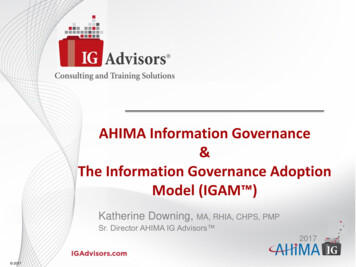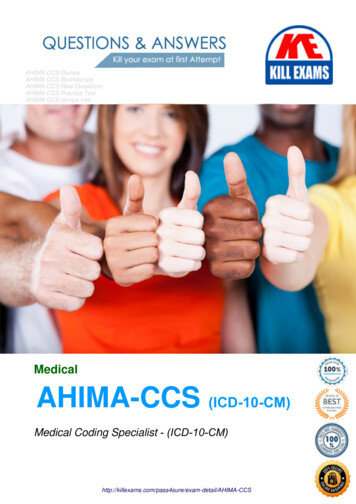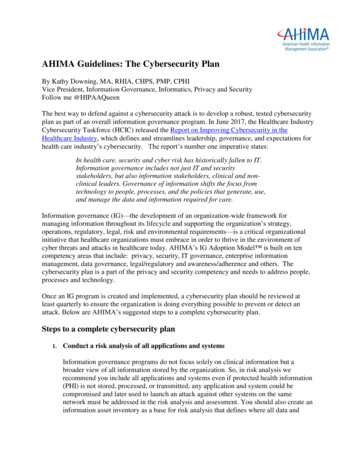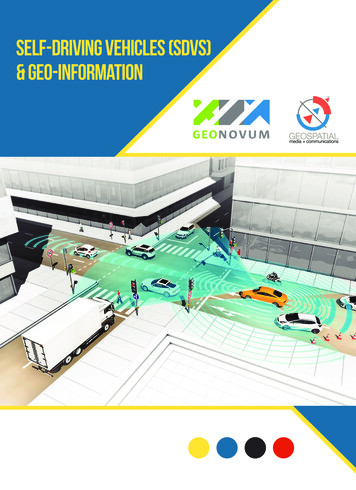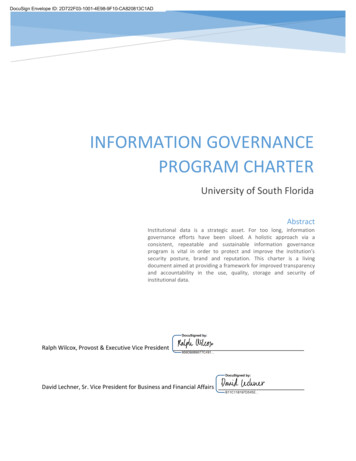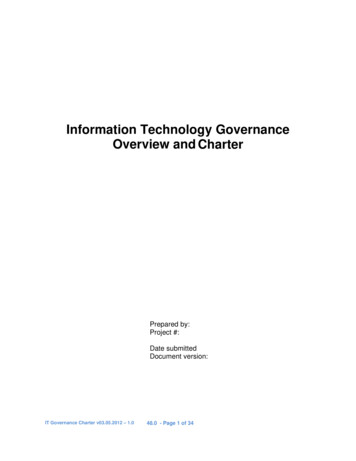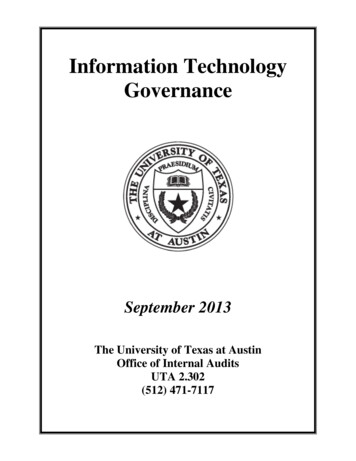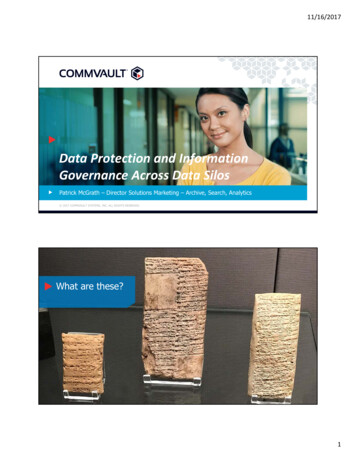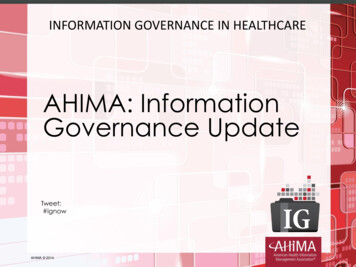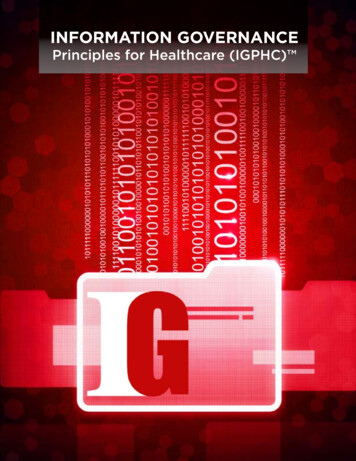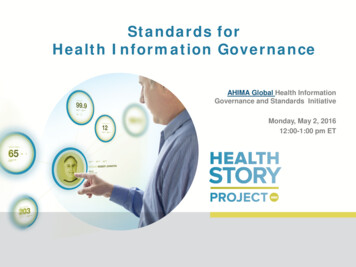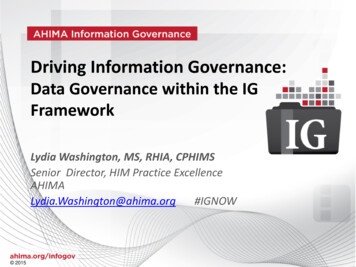
Transcription
Driving Information Governance:Data Governance within the IGFrameworkLydia Washington, MS, RHIA, CPHIMSSenior Director, HIM Practice ExcellenceAHIMALydia.Washington@ahima.org#IGNOW 2015
AGENDA Why Data Governance (DG) now How DG is different from and relates toinformation governance (IG) The primary DG functions The key DG roles The Information TrustworthinessCompetency 2015 2015
Big Data Volume Variety Velocity Veracity Value 2015 2015
Healthcare data explosion Drivers/unique data lized medicineClinical researchMobile/environmental/sensorsHealth care as a data-drivenbusiness Improvements in patient care Reduced costs Better experience and engagement 2015 2015
Managing the explosion Storage/repositories/warehouses/cloud Data management processesand practices Also a people issueTraining, policies, oversight, etc. 2015 2015
AHIMA 2015 2015 2015
7 2015
DG and IG—difference in focusData Governance Focus on inputs– Data models– MetadataManagement– Master datamanagement Single source of truth– Content management– Data security– Data qualityInformation Governance Broader, encompasses DG Focus on outputs– Sharing and disclosure HIE, e-discovery, legal holds– Privacy protections– Uses Business efficiency– e.g. Patient caredocumentation Regulatory compliance Intellectual propertymanagementEnterprise Health Information Management and Data Governance, 2015. Merida L Johns, PhD, RHIA. 2015 2015
AHIMA 2015 2015 2015
Hallmarks of Governance Strategic Supports decision-making relative todata/information Enterprise/organization level Provides controls/accountabilities 2015 2015
Knowledge Check 1:Which of the following is not a challengeassociated with big data?A. Its varietyB. The fact that it is virtualC. All of it does not have the same valueD. Veracity can be questionedCorrect Answer: B—Variety, variability in value and veracity are issuesfrequently associated with big data 2015 2015
Knowledge check 2:True or False?Information governance is focused on inputswhile data governance places moreemphasis on outputsCorrect Answer: False—Information is comprised of datawhich are the building blocks of information; dataprecedes information and therefore its governance isfocused on inputs. 2015 2015
How does Data Governance fit withInformation Governance in Your Organization? DG is part of the larger IG program anduses the IG structure Addressed in IG strategy– Business intelligence– Population Health– Analytics Beginning of the IG Journey for many 2015 2015
Five Dimensions of Data Governance 2015 2015Data ModelsMaster data management (MDM)Metadata managementData classificationData Quality Mgt
Data Models (representations of data thatdocument user and developer requirements)DG for Data Models will address: How data models are created and maintained Functions, roles, and responsibilities associatedwith data models Data dictionaries which describe entities,attributes and relationships Quality control and metrics for managing dataarchitectures 2015 2015
Master Data Management (ensuring that missioncritical data has a consistent meaning/single source of truth)MDM Functions Data collection processes Identifying master andreference data Data scrubbing Data Matching Data validation Audit/remediation 2015 2015DG for MDM addresses Identifying data ownersand stewards Bus. Requirements Development andmaintenance Security Quality metrics Change management
Metadata ManagementMetadata: A specialtype of structureddata that enablessearching,retrieval ,and useof other data andinformationresources 2015 2015Data Governance addresses: Standards and functionalrequirements Capture and maintenance Security requirements Quality controls
Data Classification Categorizes data based on its sensitivityand value. DG assures classification helpsmanage security risk and facilitates datapreservation and disposition. 2015 2015
Data Quality ManagementAHIMA DQM model 2015 2015
Data Quality Management and DG Define data quality metrics andrequirements Assure data quality management is built intobusiness processes and systems Develop policies and procedures for DQ Identify the roles and functions associatedwith achieving and sustaining DQ Provide remediation/corrective action forDQ problems 2015 2015
Information Trustworthiness: TheGoal of Data GovernanceDataquality MgtMasterData MgtTrusted DataandInformationDataModelsMetadataMgt 2015 2015DataClassification
Knowledge Check 3Which of the five functions of datagovernance specifically addresses datamatching?A. Data ModelingB. Metadata managementC. Data classificationD. Master data management (MDM)Correct Answer: D (see slide 14) 2015 2015
Knowledge check 4True or False?Ensuring that mission critical data has aconsistent meaning and is the single sourceof truth is the definition of metadatamanagement.Correct answer: False—this is the definition of master data management 2015 2015
Governance DataSteward 2015 2015
Governance RolesDataOwner 2015 2015 Decisions about dataand informationgenerated by/for thebusiness unit(s) Shift from data as theresponsibility of IT todata as theresponsibility of thebusiness owner
Information Governance vs IT GovernanceLeading the Adoption of IG in Healthcare AHIMA 2015AHIMA.ORG/INFOGOV 2015
Data Governance RolesDataSteward 2015 2015 Drives accountability in theway data and information ismanaged Business unit to IT interface Bus. Unit to Bus. Unitinterface Implements, carries outpolicies and procedures forfive DG functions SME for business unit data
AHIMA IG Adoption Model 2015
Trustworthiness as an IG Competency There is anincreasingneed to ensure thatdata andinformation istrustworthyand actionable 2015 2015
As you start on DG, consider: In what order of priority or sequence willyou address the five dimension? Overlap and dependencies? Who needs to be involved?– Decision makers– Core team Necessary skills and training? Initial goals and success measures 2015 2015
Data Governance Competency Unique to the organization No one size fits all Influencing factors– culture– communication– engagement– resources Start with SMART goals 2015 2015
Thank You 2015
IG PulseRate – a quick check into yourorganization’s IG status. Free instant assessment of the adoption level of IG in yourorganization available at www.IGIQ.org Review and rate the key success measures that impactorganizational IG adoption Evaluate your organization’s strengths and help identifyweaknesses that may be impeding your organization’s path toenterprise information governance 2015
Driving IG for HealthCare: Recommended Reading AHIMA. “Information GovernancePrinciples for Healthcare ” 2014.Chicago, IL. AHIMA, 2014. Available at:www.ahima.org/infogov Enterprise Health Information Managementand Data Governance, 2015. Merida LJohns, PhD, RHIA. ARMA International. “GenerallyAccepted Recordkeeping Principles”.ARMA International, 2013. Available atwww.arma.org The Information Governance Initiative. “TheInformation Governance Initiative AnnualReport”. 2014 and 2015 . New York, NY.www.IGinitiative.com Cohasset Associates and AHIMA. “A Callto Adopt Information GovernancePractices.” 2014 Information Governancein Healthcare. Minneapolis, MN. Cohasset Associates, 2015. CohassetAssociates and AHIMA. “ProfessionalReadiness and Opportunity” 2015Information Governance in Healthcare.Minneapolis, MN. Cohasset Associates,2015.The Joint Commission. “InformationManagement (IM) Chapter”,Comprehensive Accreditation Manual forHospitals, 2014, Oakbrook Terrace, IL: TheJoint Commission, 2014, pp.IM-1—IM-10. The Sedona Conference. “Commentary onInformation Governance” The SedonaConference Working Group Series. Aproject of The Sedona Conference Working Group on Electronic DocumentRetention and Production (WGI) 2015 2015Implementing Health InformationGovernance, 2015. Linda Kloss, MA,RHIA, FAHIMA
2015
Cohasset Associates and AHIMA. “A Call to Adopt Information Governance Practices.” 2014 . Information Governance in Healthcare. Minneapolis, MN. Cohasset Associates, 2015. Cohasset Associates and AHIMA. “Professional Readiness and Opportunity” 2015 . Information Governance
